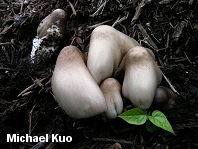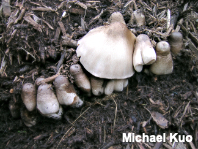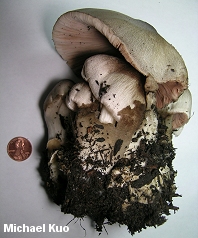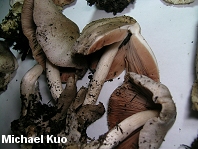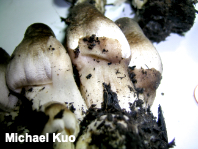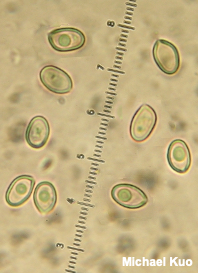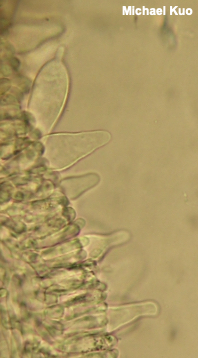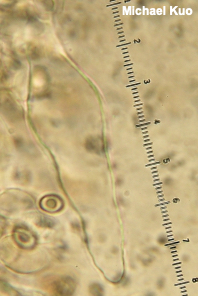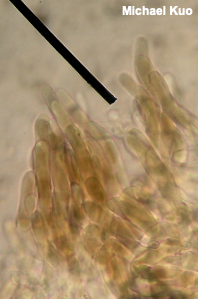| Major Groups > Gilled Mushrooms > Pink-Spored > Volvariella and Volvopluteus > Volvariella volvacea |

|
Volvariella volvacea [ Basidiomycota > Agaricales > Pluteaceae > Volvariella . . . ] by Michael Kuo This distinctive species of Volvariella is apparently not native to North America, but it has been introduced to our continent by human activity and can be found in woodchips, compost, greenhouses, and gardens when conditions are right. Volvariella volvacea is a robust species for the genus, featuring a grayish brown cap that is streaked with silky fibrils. The prominent volva at the base of the stem is brown to nearly black. Like other species of Volvariella, it features a brownish pink spore print and, consequently, gills that become brownish pink as they mature. Description: Ecology: Saprobic; growing gregariously or in clusters; found in woodchips, greenhouses, gardens, compost piles, and similar locations; capable of appearing year-round, depending on climate but usually found in summer when outdoors; apparently widely distributed (in introduced settings) in North America, but more common east of the Great Plains. The illustrated and described collection is from Illinois. Cap: 5–12 cm; conic when young, expanding to broadly conic, becoming broadly convex or bell-shaped; dry; radially streaked with silky hairs; gray to brownish gray or grayish brown or nearly black when young, with a paler marginal area; soft; the margin not lined, but often splitting with age. Gills: Free from the stem; close or nearly crowded; short-gills frequent; white becoming pink and eventually brownish pink. Stem: 6–12 cm long; 1–1.5 cm thick; equal, or tapering gradually to apex; dry; whitish or brownish; silky; the base encased in a thick, finely velvety, sack-like volva that is brownish gray to nearly black above and whitish below; volva extending 2–6 cm high. Flesh: White; unchanging when sliced. Odor and Taste: Not distinctive. Chemical Reactions: KOH negative on cap surface. Spore Print: Brownish pink. Microscopic Features: Spores 7–9 x 4–5 µm; more or less ellipsoid, or somewhat ovoid; smooth; thick-walled; yellowish in KOH; inamyloid. Pleuro- and cheilocystidia to 85 x 20 µm; mostly lageniform; smooth; moderately thick-walled; hyaline in KOH. Pileipellis a non-gelatinized trichoderm; elements brownish in KOH, up to 30 µm wide, septate, smooth; terminal cells cylindric to subclavate. Volval surface a palisade of elements 50–80 x 7.5–12.5 µm, subclavate to cylindric, smooth, thin-walled, brown in KOH. Clamp connections not found. REFERENCES: (Bulliard, 1786) Singer, 1951. (Fries, 1821; Saccardo, 1887; Coker, 1947; Shaffer, 1957; Smith, Smith & Weber, 1979; Weber & Smith, 1985; Boekhout, 1990; Monoson, Methven & Sundberg, 1993; Hemmes & Desjardin, 2002; McNeil, 2006; Justo et al., 2011b; Kuo & Methven, 2014.) Herb. Kuo 05271105. This site contains no information about the edibility or toxicity of mushrooms. |
© MushroomExpert.Com |
|
Cite this page as: Kuo, M. (2018, November). Volvariella volvacea. Retrieved from the MushroomExpert.Com Web site: http://www.mushroomexpert.com/volvariella_volvacea.html |
